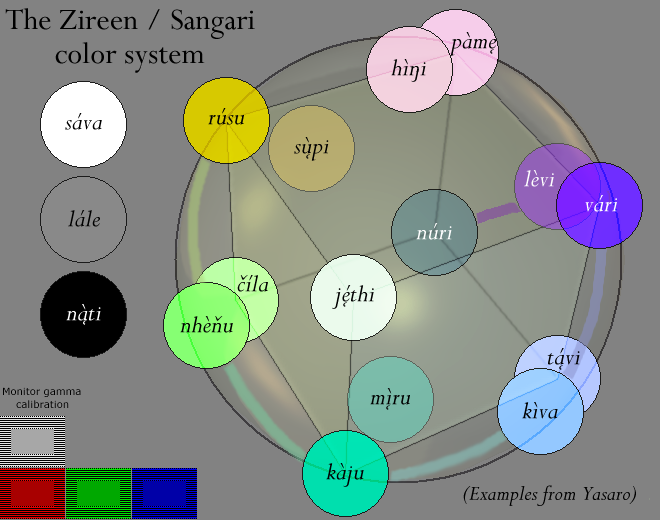Yasaro Colors
Zireen and Sangari have an additional dimension of color compared to humans. While human colors can be more or less represented by combinations of red, green, and blue light (with the exception of some highly saturated colors), Zireen/Sangari color vision has four primary colors. In the Zireen language Yasaro, the names of the primary colors are rúsu, kàju, vári, and núri. Because these are pure spectral colors, we can associate them with human color names: yellow, turquoise, indigo, and ultraviolet.
But that is just the start of the complexity. The equivalent of hue in the Zireen/Sangari color system can be represented on the surface of a sphere, with the pure spectral hues on a line winding around the sphere like the seam of a baseball. The primary hues can be placed at non-adjacent corners on an inscribed cube. Intermediate spectral hues can be placed on lines drawn on the surface of the sphere from one primary corner to another: nhèňu (green) between rúsu and kàju, kìva (blue) between kàju and vári, lèvi (violet) between vári and núri, and finally sų̀pi (no human equivalent) to close the circle from núri back to rúsu. The remaining corners of the cube can be filled with complementary colors: ję́thi (the complement of ultraviolet) is a color which appears white to humans, číla and tą́vi are combinations of ulraviolet with green and blue, and pàmę (the complement of turquoise) is another unique Zireen color with no human equivalent. The two remaining faces may be considered as the north and south poles of the sphere; they are unique Zireen colors with no single dominant wavelength. On this diagram, the top color is hìŋi, a combination of yellow and indigo, and the one at the bottom is mį̀ru, a combination of turquoise and ultraviolet.
